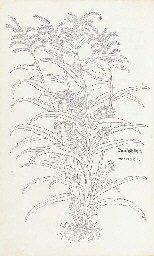KAEMPFER, Engelbert (1651-1716). Amoenitarum exoticarum politico- physico- medicarum...rerum Persicarum & ulterioris Asiae . Lemgo: Heinrich Wilhelm Meyer, 1712. 5 parts in 1 volume, 4 o (221 x 178 mm). Title printed in red and black, engraved frontispiece, 16 folding engraved plates including the map of the Persian Gulf by F.W. Brandschagen, 63 full-page plates most signed by Brandschagen, text illustrations and ornaments (few small tears, some light edgewear and spotting). (Minor browning, occasional light spotting.) Eighteenth-century vellum, morocco spine label (label chipped, hinges weak, few stains). Provenance : Nathe-Godofr. Leske (Bibliotheca Ludwigiana bookplate); Massachusetts Horticultural Society, Stickney Fund (bookplate dated 1882). FIRST EDITION, conforming to Hunt Copy 1, with plates 5E3v and 5S1v transposed and without the additional dedication portrait medal and arms. Kaempfer's wide-ranging work includes an important botanical catalogue of Japanese flora with descriptions and illustrations of nearly 500 plants listed under their Japanese names, with some, such as the Camellia, presented to Western eyes for the first time. A Swedish physician and diplomat, Kaempfer visited Persia in 1684 as part of the Swedish embassy to the Shah, and went on to visit Japan in 1690-92 as part of the Dutch East India Company. The Amoenitatum exoticarum shows his keen interest in Japan, Persia and its adjacent countries. His fascinating and curious observations encompass aspects of medicine, natural history and architecture, and include remarks on tobacco, acupunture, coronation ceremonies, ancient monuments and a section devoted to the date-bearing palm. His botanical observations are honored in the naming of "Kaemferia Linn., a genus of East Asian tropical plants of the ginger family" (Hunt). Brunet III:636; Hunt 427; Nissen BBI 1018; Wellcome III, p.376.
KAEMPFER, Engelbert (1651-1716). Amoenitarum exoticarum politico- physico- medicarum...rerum Persicarum & ulterioris Asiae . Lemgo: Heinrich Wilhelm Meyer, 1712. 5 parts in 1 volume, 4 o (221 x 178 mm). Title printed in red and black, engraved frontispiece, 16 folding engraved plates including the map of the Persian Gulf by F.W. Brandschagen, 63 full-page plates most signed by Brandschagen, text illustrations and ornaments (few small tears, some light edgewear and spotting). (Minor browning, occasional light spotting.) Eighteenth-century vellum, morocco spine label (label chipped, hinges weak, few stains). Provenance : Nathe-Godofr. Leske (Bibliotheca Ludwigiana bookplate); Massachusetts Horticultural Society, Stickney Fund (bookplate dated 1882). FIRST EDITION, conforming to Hunt Copy 1, with plates 5E3v and 5S1v transposed and without the additional dedication portrait medal and arms. Kaempfer's wide-ranging work includes an important botanical catalogue of Japanese flora with descriptions and illustrations of nearly 500 plants listed under their Japanese names, with some, such as the Camellia, presented to Western eyes for the first time. A Swedish physician and diplomat, Kaempfer visited Persia in 1684 as part of the Swedish embassy to the Shah, and went on to visit Japan in 1690-92 as part of the Dutch East India Company. The Amoenitatum exoticarum shows his keen interest in Japan, Persia and its adjacent countries. His fascinating and curious observations encompass aspects of medicine, natural history and architecture, and include remarks on tobacco, acupunture, coronation ceremonies, ancient monuments and a section devoted to the date-bearing palm. His botanical observations are honored in the naming of "Kaemferia Linn., a genus of East Asian tropical plants of the ginger family" (Hunt). Brunet III:636; Hunt 427; Nissen BBI 1018; Wellcome III, p.376.















Testen Sie LotSearch und seine Premium-Features 7 Tage - ohne Kosten!
Lassen Sie sich automatisch über neue Objekte in kommenden Auktionen benachrichtigen.
Suchauftrag anlegen